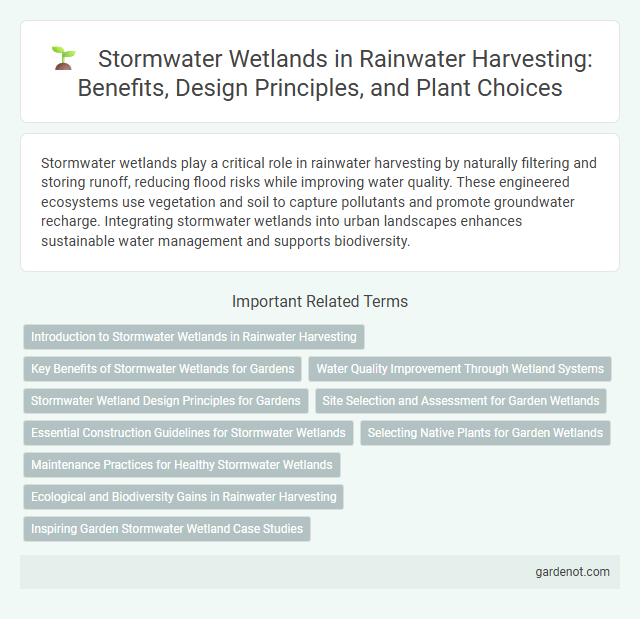Stormwater wetlands play a critical role in rainwater harvesting by naturally filtering and storing runoff, reducing flood risks while improving water quality. These engineered ecosystems use vegetation and soil to capture pollutants and promote groundwater recharge. Integrating stormwater wetlands into urban landscapes enhances sustainable water management and supports biodiversity.
Introduction to Stormwater Wetlands in Rainwater Harvesting
Stormwater wetlands serve as natural filtration systems in rainwater harvesting, capturing and treating runoff to improve water quality. These engineered ecosystems mimic natural wetlands, promoting sedimentation, nutrient uptake, and pollutant removal. Integrating stormwater wetlands in urban drainage networks enhances groundwater recharge and supports biodiversity while mitigating flood risks.
Key Benefits of Stormwater Wetlands for Gardens
Stormwater wetlands improve garden health by naturally filtering pollutants and reducing runoff, which enhances soil quality and prevents erosion. These wetlands support biodiversity by providing habitat for beneficial insects and birds, promoting ecological balance in garden environments. Their ability to retain and slowly release water increases moisture availability for plants, reducing the need for supplemental irrigation.
Water Quality Improvement Through Wetland Systems
Stormwater wetlands effectively enhance water quality by naturally filtering pollutants such as sediments, nutrients, and heavy metals through biofiltration and sedimentation processes. Vegetation within these wetlands supports microbial activity that breaks down organic contaminants, reducing nitrogen and phosphorus levels. These wetland systems also improve water clarity and oxygenation, mitigating urban runoff's negative impacts on aquatic ecosystems.
Stormwater Wetland Design Principles for Gardens
Stormwater wetland design for gardens emphasizes creating shallow basins with native wetland vegetation to maximize pollutant removal and improve water infiltration. Incorporating features like overflow outlets and sediment forebays ensures effective stormwater management while protecting plant health. Optimizing wetland size based on watershed area and anticipated runoff volume enhances the wetland's ability to treat and retain stormwater efficiently.
Site Selection and Assessment for Garden Wetlands
Site selection for stormwater wetland garden involves identifying low-lying areas with adequate soil permeability and consistent water inflow from surrounding surfaces. Assessment criteria should include watershed size, soil type, drainage patterns, and potential impact on nearby ecosystems to ensure effective pollutant removal and flood mitigation. Proximity to impervious surfaces like parking lots or roads enhances pollutant capture, while avoiding groundwater contamination risks is critical for sustainable wetland performance.
Essential Construction Guidelines for Stormwater Wetlands
Stormwater wetlands require precise site assessment, including soil permeability and hydrology analysis, to ensure effective water retention and filtration. Constructed wetlands must incorporate a multilayered substrate system with appropriate vegetation, such as native wetland plants, to promote pollutant removal and wildlife habitat. Proper inflow and outflow structures, alongside sediment forebays, prevent erosion and maintain long-term functionality of stormwater treatment.
Selecting Native Plants for Garden Wetlands
Selecting native plants for stormwater wetland gardens enhances water filtration and supports local biodiversity by providing habitat for wildlife. Native species such as sedges, rushes, and cattails are well-adapted to fluctuating water levels and improve nutrient uptake, reducing pollutants in collected rainwater. Incorporating diverse native plants increases wetland resilience and promotes ecological balance within rainwater harvesting systems.
Maintenance Practices for Healthy Stormwater Wetlands
Regular removal of accumulated sediments and invasive vegetation is essential to maintain the ecological balance and water quality of stormwater wetlands. Routine inspection of inlet and outlet structures ensures unobstructed water flow and prevents flooding or stagnation. Periodic monitoring of vegetation health and soil conditions supports nutrient removal processes and enhances habitat for native wildlife species.
Ecological and Biodiversity Gains in Rainwater Harvesting
Stormwater wetlands significantly enhance ecological health by providing habitat diversity that supports native flora and fauna, increasing biodiversity in urban and suburban areas. These wetlands improve water quality through natural filtration processes, reducing pollutants and promoting the growth of aquatic species. Integrating stormwater wetlands into rainwater harvesting systems fosters ecosystem resilience and contributes to sustainable water management practices.
Inspiring Garden Stormwater Wetland Case Studies
Stormwater wetlands serve as natural filtration systems that effectively reduce pollutants and manage runoff in urban environments. The Inspiring Garden Stormwater Wetland case studies demonstrate how integrating native vegetation and engineered landscapes enhances water quality and supports biodiversity. These projects highlight measurable improvements in reducing sediment, nitrogen, and phosphorus loads, showcasing scalable models for sustainable stormwater management.
Stormwater wetland Infographic

 gardenot.com
gardenot.com